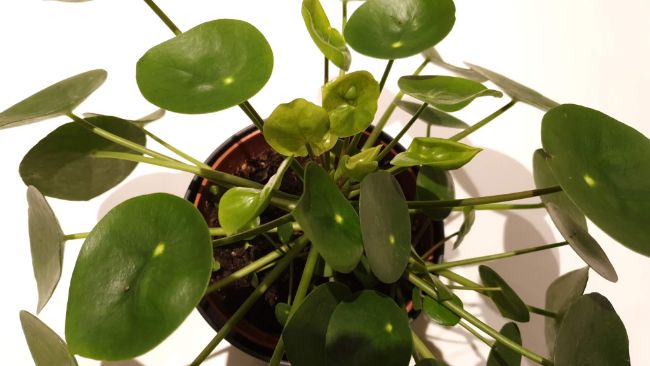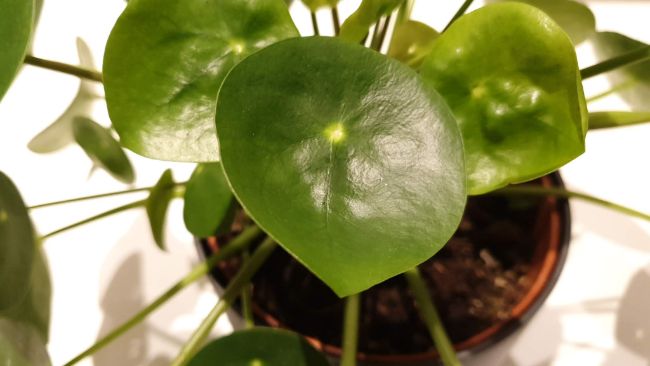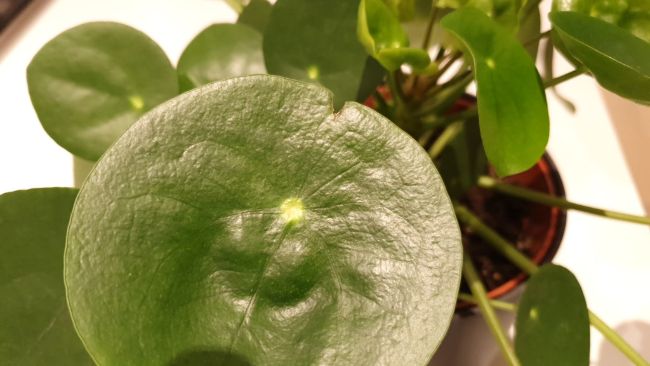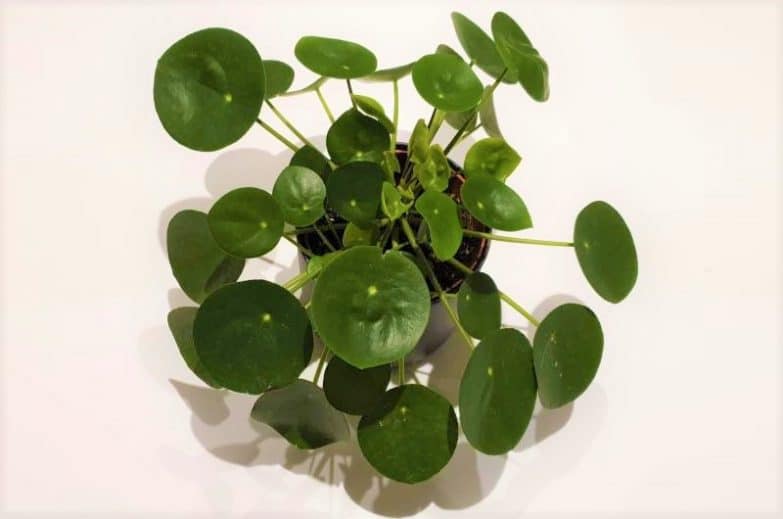The Chinese Money Plant (Pilea peperomioides) has become something of a must-have houseplant in recent years. The Chinese name for this plant translates to flat-faced grass. Unfortunately, it’s very common to find your Chinese Money Plant leaves curling, and it can be challenging to find out why. This article is here to help!
Chinese Money Plant leaves curling is most commonly due to low light, temperature extremes, or watering problems. New leaves are naturally curled and will flatten with time. Bright, indirect light, temperatures of 55-65°F (13-18°C), and close attention to watering can prevent and fix curling.
It isn’t always easy to determine why your Pilea peperomioides has curling leaves, so you will need to look for other clues to help you work out the problem. This article will help to explain the different types of curling, the other symptoms to look for, and how to fix the cause of each issue.
Types Of Chinese Money Plant Leaf Curling
Pilea peperomioides plants can tell you a lot of information through their leaves, but their language is poorly understood, so it takes a little time and patience to learn.
There are three ways that Pilea leaves can curl, and the pattern of curling in your plant can help you determine what the problem is;
- Outward Leaf curl (Doming) – Ths is most commonly caused by low lighting and overwatering.
- Inwards Leaf Curling (Cupping) – This is most commonly caused by high temperatures, drafts, underwatering, or nutrient deficiency.
- Mixed Leaf Curling – Sometimes a Pilea peperomioides can have leaves that curl in both directions, or have leaves that have partial cupping or doming. This often indicates several issues that need to be resolved.
Causes Of Chinese Money Plant Leaves Curling

New Leaves
The most important thing to note is that almost all Pilea peperomioides plants will show curling leaves at some stage, and often this is normal. New leaves are curled when they first appear and can take some time to flatten out.
New leaves develop from the top of the stem, so if you notice it is only the leaves at the top of the plant that are curling, and the rest of the plant appears healthy, then do not worry. Simply observe your plant, and try to provide conditions that help it to thrive.
Low Light
This is one of the most common causes of outward leaf curl, or doming. The outer edges of the leaf curl back as the center of the leaf pushes forward to form a sort of dome shape. The leaves respond to low light conditions by exposing as much of their surface area as possible to what light there is in order to maximize photosynthesis.
I noticed this most clearly when I purchased a Pilea peperomioides plant online. It was wrapped up without access to light for several days during shipping, and when it arrived, it looked healthy, but many of the leaves were showing quite significant cupping.
When I placed my plant in bright, indirect light, the leaves flattened out over the space of several weeks.
Position your Chinese Money Plant in a bright location, but avoid direct sunlight, as this can cause scorching of the leaves. Bear in mind that light levels will change a lot depending on the season and weather outside, so you may have to move your plant over the course of the year.

Overwatering
Much of the change in shape of the leaves of a Pilea peperomioides plant is caused by changes in the water content of the leaves. If you are overwatering your plant, the leaves will absorb more water than is ideal, and this can lead to distortion of the normal flat shape of the leaves, resulting in curling.
I have noticed that overwatering usually tends to cause downward curling or doming of the leaves, as they expand to try to maximize the amount of water that they hold.
If you think overwatering may be the cause of your Chinese Money Plant leaves curling, look for other symptoms of this, such as generally yellowing leaves, water pooling in the drip tray, or signs of root rot.
Factors that predispose to overwatering include;
- Using a pot that is too large for the plant.
- Putting your plant in a pot with no or few drainage holes.
- Watering your plant on a schedule, rather than checking the soil, to see if your plant needs watered.
- Planting in poorly draining soil.
- Growing your plant in cool, dimly lit conditions, where water use will be reduced.
If you think your Chinese Money Plant has curled leaves due to overwatering, correct any of the issues mentioned above and cut back on watering, letting at least the top 1-2 inches of soil dry out before watering.
If root rot has set in, read this article to try to fix your plant, or consider propagating your plant using this step by step guide.

Temperature Problems Causing Leaf Curling On Your Pilea Peperomioides
Many people assume that Pileas prefer warm temperatures, but they actually prefer things on the cool side. Warm temperatures will often encourage your Chinese Money Plant to develop curled leaves.
The leaves are more likely to curl upwards or become cupped if the temperature is too warm. This is most likely due to the increased water loss from the leaves that occurs when temperatures are too high.
Pilea peperomioides prefers temperatures of 55-65°F (13-18°C), but they can easily tolerate temperatures as low as 45°F (7°C).
If your Pilea is being kept in temperatures above this range, try to gradually reduce the temperature, rather than make a sudden change that could further stress the plant.
Coming from areas of China that are not too far from the equator means that these plants have evolved in conditions where massive spikes or rapid drops in temperature are uncommon.
In more northern climates, where we alternate from using central heating in the winter months to fans or air conditioning in the summer, our house temperatures may be more erratic. These temperature fluctuations can also result in your Chinese Money Plant leaves curling.
Try to avoid temperature fluctuations. Don’t place it near doors and windows, or artificial heating and cooling systems. It may be that you need to move a thermometer around the room for a few days to find a place where the spikes and troughs are least extreme.
Underwatering Or Inconsistent Watering
Another watering issue that can cause your Chinese Money plant to get curled leaves is underwatering. In response to a lack of water, the leaves will curl to reduce the surface area of the leaf and reduce water loss.
Make sure you water your Chinese Money Plant before the soil dries fully or the plant starts to wilt. Check on your plant every few days and water when the plant needs a drink, rather than on a schedule. Read my guide to watering houseplants for more great tips to help.
Inconsistent watering is also an issue that can cause leaf curling, and is more likely to cause a combination of leaves that curl up and down. Water scarcity, followed by an abundance leads to the leaves trying to conserve water, and then absorb more than they need. Repeated cycles of this can lead to marked deformity of the leaves.
I have also noticed that the leaves can sometimes split if there is inconsistent watering. As the leaf goes from being curled upwards and dehydrated, to being filled with water, the edges of the leaves can be put under considerable strain and split. This can spoil the look of the plant.
Always try to be as consistent as possible when watering your Pilea, and all of your houseplants.

Humidity
There have been some suggestions that leaf curl may relate to humidity issues but I do not think that this is a significant factor. Pilea peperomioides prefers moderate to high humidity, but I have not noticed any major negative effects from humidity levels as low as 20%.
Pilea peperomioides has some succulent features, which make it reasonably resistant to low humidity and relative water scarcity. However, it is nowhere near as tolerant as other more hardy succulents.
Low humidity levels can predispose your Pilea peperomioides plant to brown leaf edges, so it is usually better to provide at least moderate humidity of 40-50% if possible.
What Causes The Bottom Leaves To Curl And Turn Yellow?
There are three possibilities if your plant is doing this. Ageing leaves do eventually go yellow and fall off and it is all part of the cycle of life.
The next thing to check is to make sure you are not overwatering your plant, as this will cause generalized leaf yellowing and curling.
The third potential problem is nitrogen deficiency. Pilea plants don’t need a lot of fertilizer, but if you have not fed your plant in the last year, this is definitely on the list of possibilities.
If you are confident you are not overwatering your plant, I suggest removing the yellow leaves and feeding the plant with a balanced houseplant fertilizer. Fertilizing monthly during spring and summer is a good regime.
How To Fix Chinese Money Plant Leaves Curling And Falling Off?
This is most likely due to underwatering or temperature stress. Severe underwatering will cause significant leaf curling. It can also result in older leaves turning brown or yellow and dropping from the plant.
Be aware that these symptoms can also be caused by severe overwatering that has resulted in root rot.
Last Word
Chinese Money Plant leaf curling can be a tricky problem to deal with and there are a lot of conflicting opinions regarding the causes and solutions. The main reason for this is that there are many causes, and every plant is grown in slightly different conditions.
However, if you focus on providing optimal care conditions, and correct any obvious issues, your Pilea peperomioides will usually develop healthy growth and your problems with leaf curling will slowly resolve.

